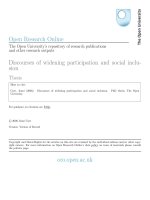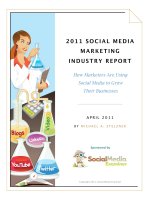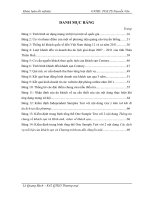- Trang chủ >>
- Khoa học xã hội >>
- Báo chí
E-san folksongs: E-san identity and social media
Bạn đang xem bản rút gọn của tài liệu. Xem và tải ngay bản đầy đủ của tài liệu tại đây (852.17 KB, 5 trang )
E-SAN FOLKSONGS: E-SAN IDENTITY AND SOCIAL MEDIA
Hataiwan Maneewong
Ph.D. Student of Thai Language, Faculty of Humanities and Social Sciences, Khon Kaen
University, Thailand /Lecturer of Nakhon Ratchasima RaJabhat University.
Rattana Chanthao
Faculty of Humanities and Social Sciences, Khon Kaen University, Thailand
Abstract
The objective of this article is to study E-san identity through online social media.
The study data and information are collected from 15 E-san folksongs that broadcast in
online social media selected only songs that earn more than 10 million views. It is found
that folksongs on online social media, to date, has much influenced E-san identity, since
online social media is easily connected with common people. As a result, people no matter
where they live are able to acknowledge and understand E-san identity.
Key Words: Identity, E-san, Online Social Media, E-san Folksongs
1. Introduction
E-san region is the largest region of Thailand, so E-san identity study is interesting,
as E-san region aspect is different from other regions in many ways. Importantly, E-san
region consists of various groups of people such as E-san-Laotian, Laotian from Laos,
Kuy, Nyaw, Tai Phuan, Phu Thai, etc. These groups of races have their own history and
tradition before. There are sources providing information for the identity study especially
from anthropological study such as legends, tales, rituals, and folksongs.
2. E-san Folksongs
Thai songs has evolved for a long time from native folksongs, lullabies, Pleng
Kiaw Khao, Pleng Mho Lam Mho Kan, Pleng Bog to present folksongs (Kingkaew
Attakorn, 1976). These songs contain different contents and melodies according to
environment and way of life of each locality particularly folksongs which is one of the
literatures that narrate local stories efficiently. Wit Sivasriyanon (1971: 95-97) stated
that literatures and society influence each other, since literatures recorded stories of a
society in that time intentionally or unintentionally by the creators of literatures.
Therefore, folksong literatures can be accounted as a method in recording and depicting
stories of local life.
Sa-nga Kanchanapan (2003: 46) said that Thai folksongs have been influenced
by native folksongs and traditional Thai songs of which words and lyrics can be
understandable easily, and the melodies are both adapted from the traditional songs and
newly arranged and composed. Most of them are easy listening, and uttering is used for
449
singing. The contents of the songs are widely related to Thai society value and the local
way of life, for not only the folksongs reflecting the local life in agricultural way, but also
indicating the strong bond between the people and tradition, culture, religion, and belief.
These are the key leading the listeners to understand the local Thai society identity.
E-san folksongs is remarkable in word expression, melody, content, and literary style
which is highly valuable in literature. As well, E-san folksongs carry on beliefs, values,
ideas, traditions, and social ideals which are considered as a local heritage (Lakkhana
Suksuwan. 1978: 59). People that appeared in the songs mostly are rural or poor, and they
describe their love, working, housing, dressing, dietary, entertainment, and sometimes the
reflections of belief and the reflections of the belief and value system of their locality like
superstition and astrology, nation, religion and monarch. It is also included the materialistic
values in wealth and properties, values in estates and power, values in city life, values in
allurements and feminine. It is sometimes reflected in some songs when a female lost
virginity or beguiled by a man from a city, the woman will be blamed, etc.
E-san folksongs change accordingly through ages. To be clarified, when a cassette
recording business losted its popularity, the investors had their singers recording their
songs, only one or two, as a ―single‖ to estimate the sales. If any single earned well
reputation, that singer then had a chance to release a compilation or a long-play
consecutively. Later on when the digital period had come up, Thai songs imitated foreign
songs, or they was called string songs. Luk Krung songs gradually faded away, and Thai
folksong business were very marginally. Business was fully covering Thai music. The
advancement of technology raised its role in the business. There was no longer recording
that recorded all instruments in one time, since it changed to be partially recorded. Besides,
there is an online broadcasting through social media instead of releasing as a single. There
is a motion picture for a song or a music video, so listeners can appreciate the content of a
song through the acting in a music video, instead of listening the song only. There are
many songs that are interested and imply social culture within.
3. Online Social Media
Online social media is a media that a sender shares the formation that in various
formats to the receiver through online network in which they can interact to one another or
between sender to receiver, or one receiver and another receiver. Online social media is
divided by frequent using including Blogging, Twitter and Microblogging, Social
Networking, and Media Sharing.
To date, online social media role affects the life of people in the society much. It is
obvious that we can simply access or use online media via communication devices like
computers, mobile phones, tablets, or other devices that can access to internet connection
or mobile phone networking. From a report of ETDA (Electronic Transactions
Development Agency (Public Organization)), Ministry of Information and Communication
Technology, that surveyed internet usage behavior of Thai people in B.E. 2017, it is found
that the top three of the most popular online social media were Youtube at 97.1%,
Facebook at 96.6%, and Line at 95.8%, respectively.
450
Image 1, Source: />3. Folksongs and Online Social Media
The role of online social media does not affect only the way of life of common
people in communication but also E-san folksongs in identity distribution of the
northeastern people to be known and understood widely.
As mentioned above, now Thai folksongs are in the digital age, so be E-san
folksongs. To be clarified, access to E-san folksongs does not longer require any cassette
or any CD. People can get an access to E-san folksong easily and fast including the motion
picture that help people to be more understood and acknowledged the condition of E-san
society especially through the most popular online social media like YouTube and
Facebook, which publishing E-san folksongs and make the songs to be popular as well.
To be an example, I pick up one of E-san most popular folksongs this time around,
which contains not only attractive melody, but its content and music video as well. It is
very interesting because this song can represent E-san people‘s lifestyle including beliefs,
tradition, culture, and their living. The song is named Tao-Ngoi by Jintara Poonlap. The
story of this song is about a girl from Tao-Ngoi District, Sakon Nakhon provice, who has
been waiting for her lover from the same district, and it is described in the song that she
keeps thinking of him until it causes her body lean. Simultaneously, in the lyrics, there is
an implication of E-san identity of people in Sakon Nakhon province including their belief
that Tao-Ngoi statue can be blessing and give one fortunate, the origin of E-san rocket (Pha
Daeng Nang Ai), etc. other than the lyrics, the music video also shows the locations and a
worshipping tradition in this region.
451
Image 2-3, Song “Tao-Ngoy” by an artist named Jintarha Poonlap
Source: />There is another popular song that can be a good example as well, the song called OLa-Nor by an artist named Kong Huai Rai. It is a story of a local E-san boy who tried to
change himself according to the fashion trend of Korean dressing style, listening to modern
music, and living as modern as city life does, but finally he fails to change because of his
E-san blood inside his body brings him back to the reality. In the end, he accepts his identity.
The words of the song reflect E-san society nowadays that E-san teenagers or new
generation are trying to keep away their identity including tradition, culture, living style,
etc., but finally there is no E-san offspring can leave E-san identity. The music video
shows precisely clear images of E-san lifestyle and culture even in a few minutes.
452
Image 4-7, Song “O-La-Nor” by an artist named Kong Huai Rai
Source: />3. Conclusion and Discussion
From the sample songs above, we can see that online social media performs it role
against E-san folksongs in E-san identity very well, for online social media, to date, has
diversity and is the fastest and easiest media to access as well as it can be approaching
most people. Therefore, online social media is initially important in E-san society identity
distribution to public to understand and connect.
4. Reference
1. Electronic Transactions Development Agency. How Thai People Use the
Internet in Year 60 [Online]. Source: 2017.html [19 March 2017]
2. Hathaiwan Maneewong. (2012). Metaphors Related to Males and Females in Esan Folksongs. Master of Arts Thesis Khon Kaen University. Jintara Poonlap. Pleng Tao-Ngoi
[Online]. Source: [19 March 2017]
3. Kingkaew Atthakorn. (1976). Folkloristics. Education Supervisory Document
Issue 184. Bangkok : Supervisory Unit Kong Huai-Rai. Pleng O-La-Nor [Online]. Source
: [19 March 2017]
4. Lakkhana Suksuwan. (1978). Folksong Literature. Master Degree Thesis
Srinakharinwirot University.
5. Pichit Vichitbunyarak. (2001). Online Social Media : Media of the Future.
Executive Journal Year 31 Issue 4 (October-December) Page 99-103.
6. Somchai Srinok. (2010). Belief Development and Valuables that Influence Belief
of Goodness and Sin in E-san Folksongs. Buddhist Studies Thesis Journal Page 320-330.
7. Sugri Charoensuk. (1989). How to Appreciate Music. Bangkok : Ruenkaew
Ruenkwan Printing.
8. Waew Palangwan. (2002). E-san Folks. Bangkok: Ruenpanya.
453









